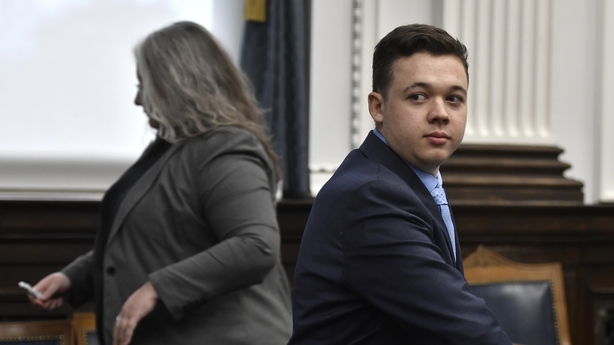The prosecution at the murder trial of Kyle Rittenhouse have accused the teenager of provoking the confrontation that led to him shooting three men during a volatile protest over race and policing in Wisconsin last year.
Kenosha County Assistant District Attorney Thomas Binger told the jury to ignore Mr Rittenhouse's argument that he was attacked and fired his semi-automatic AR-15-style rifle in self-defense, killing two men and wounding a third.
Instead, Mr Binger said, Mr Rittenhouse instigated the fatal clashes by brandishing his weapon.
Mr Binger tried to demonstrate this by raising the gun in front of the jury. "That is what provokes this entire incident," he said.
"You cannot hide behind self-defense if you provoked the incident. If you created the danger, you forfeit the right to self-defense by bringing that gun, aiming it at people,threatening people's lives. The defendant provoked everything," the prosecutor said.
After he spoke, the defense began its final address to the jury and was expected to highlight the considerable evidence presented at trial supporting Mr Rittenhouse's argument that he was attacked.
The trial is the most closely watched case involving a civilian's right to self-defense since George Zimmerman was acquitted in the fatal shooting of Trayvon Martin, an unarmed Black teenager, in 2013.
Like Zimmerman, Mr Rittenhouse has emerged as a divisive figure, viewed as heroic by some conservatives who favour expansive gun rights and as a symbol of an out-of-control American gun culture by many on the left.
Multiple witnesses have testified that Joseph Rosenbaum, one of two men Mr Rittenhouse fatally shot, had charged and lunged at the teenager.
"Mr Rosenbaum was shot because he was chasing my client and going to kill him - take his gun and carry out the threats he made," Mark Richards, Mr Rittenhouse's attorney, said in his closing argument.
Mr Rittenhouse, 18, is charged with killing Mr Rosenbaum, 36, and Anthony Huber, 26, and wounding Gaige Grosskreutz, 28, on 25 August 2020.
The shootings took place in Kenosha, Wisconsin, during protests that followed the police shooting of a Black man, Jacob Blake, who was left paralysed from the waist down.
Mr Rittenhouse, who has pleaded not guilty and testified last week that he acted in self-defense, faces life in prison if convicted. He was 17 at the time of the shootings.
 After the defense presents its closing arguments, the jury will begin deliberations and attempt to form a consensus on guilt or innocence.
After the defense presents its closing arguments, the jury will begin deliberations and attempt to form a consensus on guilt or innocence.
The closing arguments are the lawyers' last chance to influence a jury which has heard evidence supporting Mr Rittenhouse's argument that he was attacked before he fired his rifle.
In his testimony the teen, at times losing his composure and crying, said he did not want to kill anyone that night.
For the prosecution, Mr Binger said Mr Rittenhouse had gone out of his way to travel to Kenosha from Antioch, Illinois, during the protests, one of a series of demonstrations in 2020 against racism and police use of force.
"This isn't a situation where he was protecting his home or his family," Mr Binger said.
In an effort to argue that Mr Rittenhouse acted recklessly, Mr Binger talked at length about the powerful nature of an AR-15 and the ammunition it was loaded with: full metal jacket bullets designed to penetrate their target.
He called Mr Rittenhouse a"fraud" for claiming that he was there as a medic to provide first aid. "This AR-15 is completely incompatible with the role of a medic," Mr Binger said
The jury was shown graphic video of Mr Rosenbaum after he was shot four times, lying motionless and struggling to breathe.
Mr Binger also displayed a close-up graphic photograph of Mr Grosskreutz with a large chunk of his right arm shot off. Several jurors appeared to wince and turn away.
Citing grainy video evidence, Mr Binger argued that Mr Rosenbaum had charged after Mr Rittenhouse in an attempt to "try and stop the defendant from pointing his gun or shooting anyone" and that it was Mr Rittenhouse who had provoked the encounter.
Under Wisconsin law, a person who has provoked a confrontation must exhaust all other options before resorting to deadly force, and Mr Binger told the jury that Mr Rittenhouse could have continued to run away from Mr Rosenbaum.
Mr Binger also said that Mr Huber, a protester who was shot after striking Mr Rittenhouse with his skateboard, was trying to disarm the teenager.
Earlier, the trial judge dismissed a misdemeanor charge against Mr Rittenhouse for illegally possessing the AR-15-style rifle he used in the shootings.
Judge Bruce Schroeder sided with the defense argument that there were exceptions in the law that appeared to allow for Mr Rittenhouse to possess the semi-automatic rifle.
While a misdemeanor charge, its dismissal carries symbolic significance for a case that has captured the attention of the public in part because it involved a teenager roaming the streets with a semi-automatic rifle who was not immediately brought into custody by the police in Kenosha.

